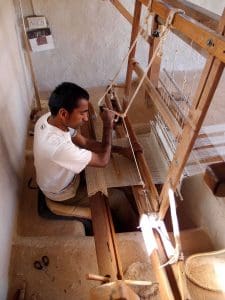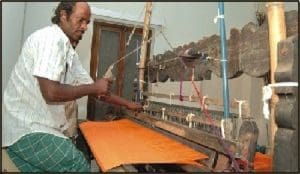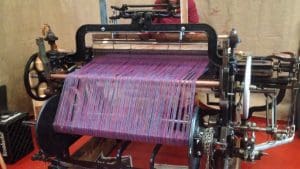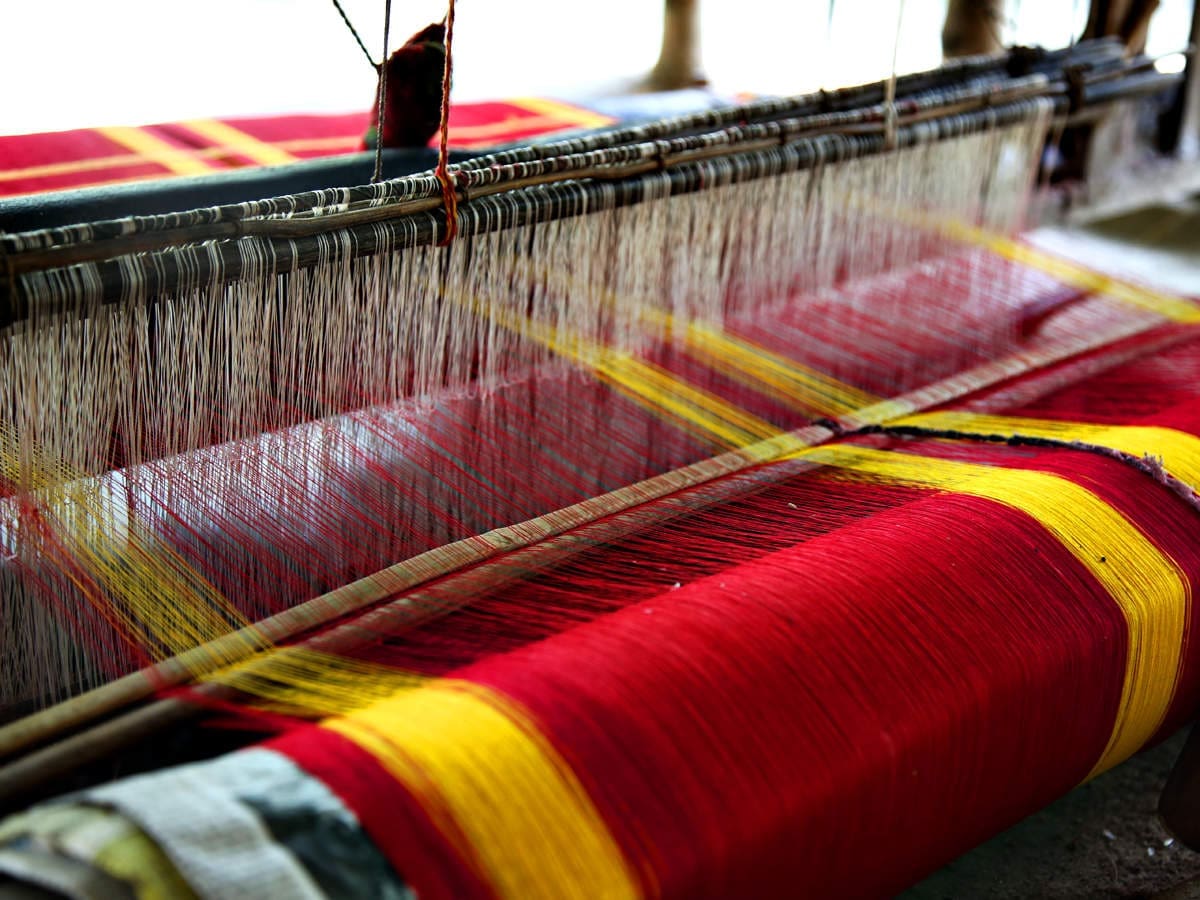A loom is a machine or device which is used to produce the woven fabric. It is the central point of the whole process of cloth production. In other words, a loom is a mechanism or tool used for weaving yarn and thread into textiles. Looms vary in a wide assortment of sizes. They come in huge free standing handlooms, tiny hand-held frames, to vast automatic mechanical tools. A loom can as well pertain to an electric line construction like that of a wiring loom. The main task of looms is to clutch the twist threads under pressure to enable the progress of the interweaving of the woof strands. The loom’s system and exact form can diner to some extent; however it still performs the basic application.
MANUAL/HANDLOOM
- PRIMITIVE OR VERTICAL LOOM.
- PIT LOOM: a) Throw shuttle. b) Fly shuttle.
- FRAME LOOM: a) Throw shuttle. b) Fly shuttle.
- CHITTARANJAN LOOM.
- HATTERSLEY LOOM.
- PRIMITIVE OR VERTICAL LOOM.

A primitive loom is generally by sinking the frame into the ground and the work inside the pit by both feet. The framework is of bamboo. This loom had been known to be in use in 5000 to 6000 years B.C. This loom is still used for weaving silk pieces, silk shirting, and sarees, Muslim, etc.by derivative weavers.
FEATURE:
- This type is loom used for finer yam.
- This loom has to be known to be in use 600 yarn B.C
- This is throw shuttle loom
- Made of wood or metal
- It must be heavy and smooth
ADVANTAGE:
- The first fabric is produce
- By skilled labor we can get very quality fabric
- Set-up cost is very low
- Primitive loom can work with dobby & jacquard attachment.
DISADVANTAGE:
- Slay is suspended from the top and its action is very weak using a compact or heavy cloth.
- Warp threads are drawn directly from the warp beam.
- Primitive loom accommodative a small can weft.
2. PIT LOOM

Pit loom This loom is created by sunken four posters into the ground and with an overhang sley. The thread work inside the pit, so that the warp threads may absorb moisture and better weaving will result.ln, this looms the combination of sley & shuttle boxes.ln 1733 A.D John kay of Bury, England invented the”Fly Shuttle”.This invention was an extremely important event in the history and development of weaving.
FEATURE:
- It fl shuttle loom
- Its production is double because by the introduction of sley,shuttle-boxes
- An average weaver cans weave a medium width fly-shuttle loom at 80-110 pics per minute.
- Shuttle is transfer one box to another box
- To control moisture loom are settled in floor that way yarn can get moisture
- By this loom we get texture fabric.
ADVANTAGE:
- Production is high
- Moisture can easily control
- May produce texture fabric
- An average weaver can weave
- Fly shuttle pit-loom, back and beast beam has been introduced to remove these difficulties like (knot, yarn, breakage, etc)
- It can accommodate a greater quality of weft in the pirn.
DISADVANTAGE:
- Difficult to control more number of heald shaft
- This is one kind of handloom so large scale production is impossible
- To set the loom is difficult.
- FRAME LOOM:

Frame looms almost have similar mechanisms that ground looms hold. The loom was made of rods and panels fastened at the right angles to construct a form similar to a box to make it more handy and manageable. This type of loom is being utilized even until now due to its economy and portability.
FEATURE:
- This type of loom made on a frame
- The movement of the slay is given by the left hand of the weaver
- Twill, satin another weave more number may produce
- Beam dia may high by weaving
ADVANTAGE:
- It has an increased speed one hand of the weaver operates the picking handle and the other remains free to operate the slay
- Fabrics of long width can as conveniently be woven as narrow ones
- Larger number of heald can conveniently be operated
- Ensure better selvage
- Let off is done with a pawl lever arrangement.
DISADVANTAGE:
- Cloth beam dia increase and make it very large
- Difficult to fit the level
- Fabric may compact
- CHITTARANJAN LOOM.

Chittaranjan type of semiautomatic loom of sturdy construction made of iron and wood commonly used in Bengal is known as Chittaranjan loom. This loom also called Japan loom.
FEATURE:
- The principal characteristic of this loom lies in its beating up take up and let off motion
- For beat up, two wheels upon the top shaft connect the slay at two ends with two livers
- A five wheel positive take-up motion has been adopted to regulate pics per inch
- Production rate is high
- Shedding & picking motion in this loom work as fly shuttle loom.
ADVANTAGE:
- An average can conveniently run this loom
- In 80 percent Efficiency, this loom run at 120 to 140 picks per minute
- It ensures uniformity in the insertion of picks per inch by the use of five wheels positive take-up motion
- It also ensures uniform beat up
- It is more suitable for weaving medium and coarse fabric then finer ones
- The sweep of slaying to produce terry piles
DISADVANTAGE:
- This is not an automatic loom
- Five wheels positive take-up motion is used which gives jerky motion
- Precise control of a fraction of pick is not possible
- Production rate is less over the then modern loom
5. HATTERSLEY LOOM

Hattersley Loom: ln 1856 Hattersley and hill of Keighley, Yorkshire act in the same manner as a power loom excepting the movement of the slay which may either be operated manually or by motive power to the top shaft, but the loom is constructed with lighter forming.
FEATURE:
- This is the same manner of the power loom
- This loom is lighter than power loom
- Shredding, picking, beating up, taking up, and let off motions are automatically operated.
- For taking up five wheels take-up motion is used.
- Shedding is formed from the bottom shaft in case of the plain weave.
ADVANTAGE:
- Maximum motion are motive by power
- This loom is lighter than power loom
- It also ensures uniform beat up.
- It ensures uniform insertion of pick
- An average weaver can conveniently run this loom.
DISADVANTAGE:
- For driving manually more than 50″ read space is not control
- A weaver can not weave a long time.
- Five wheels take up give jerky motion.
REFERENCE:-
Webpage
- http://www.preiectile loom.com
- http//www Rapier Imm com
- http://www.Water loom.com
- http//www power mm com
- http://www.chcmhcritagc.org.com
Books
- Weaving Mechanism, N.N.Banerjee
- Studies in Primitive looms, H. Ling Rock
- Fabric Manufacturing Technology-IV, Md. Al-Amin Sheikh
- Weaving Machine, mechanism & Management, Talukder
- Special Fabric Production, Md. Al-Amin Sheik.

Article written by Swati Patali B.Sc in Textile and Apparel Designing from Sir Vithaldas Thackersey College of Home Science. Textile Value Chain intern.

